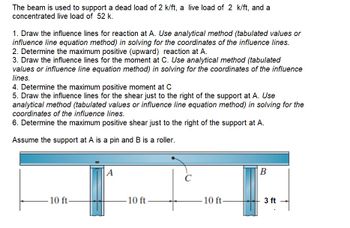The beam is used to support a dead load of 2 k/ft, a live load of 2 k/ft, and a concentrated live load of 52 k. 1. Draw the influence lines for reaction at A. Use analytical method (tabulated values or influence line equation method) in solving for the coordinates of the influence lines. 2. Determine the maximum positive (upward) reaction at A. 3. Draw the influence lines for the moment at C. Use analytical method (tabulated values or influence line equation method) in solving for the coordinates of the influence lines.
The beam is used to support a dead load of 2 k/ft, a live load of 2 k/ft, and a concentrated live load of 52 k. 1. Draw the influence lines for reaction at A. Use analytical method (tabulated values or influence line equation method) in solving for the coordinates of the influence lines. 2. Determine the maximum positive (upward) reaction at A. 3. Draw the influence lines for the moment at C. Use analytical method (tabulated values or influence line equation method) in solving for the coordinates of the influence lines.
Chapter2: Loads On Structures
Section: Chapter Questions
Problem 1P
Related questions
Question

Transcribed Image Text:The beam is used to support a dead load of 2 k/ft, a live load of 2 k/ft, and a
concentrated live load of 52 k.
1. Draw the influence lines for reaction at A. Use analytical method (tabulated values or
influence line equation method) in solving for the coordinates of the influence lines.
2. Determine the maximum positive (upward) reaction at A.
3. Draw the influence lines for the moment at C. Use analytical method (tabulated
values or influence line equation method) in solving for the coordinates of the influence
lines.
4. Determine the maximum positive moment at C
5. Draw the influence lines for the shear just to the right of the support at A. Use
analytical method (tabulated values or influence line equation method) in solving for the
coordinates of the influence lines.
6. Determine the maximum positive shear just to the right of the support at A.
Assume the support at A is a pin and B is a roller.
10 ft-
A
10 ft
C
10 ft-
B
3 ft
Expert Solution
This question has been solved!
Explore an expertly crafted, step-by-step solution for a thorough understanding of key concepts.
Step by step
Solved in 4 steps with 3 images

Follow-up Questions
Read through expert solutions to related follow-up questions below.
Follow-up Question
Continue answering numbers 4, 5, and 6.

Transcribed Image Text:The beam is used to support a dead load of 2 k/ft, a live load of 2 k/ft, and a
concentrated live load of 52 k.
1. Draw the influence lines for reaction at A. Use analytical method (tabulated values or
influence line equation method) in solving for the coordinates of the influence lines.
2. Determine the maximum positive (upward) reaction at A.
3. Draw the influence lines for the moment at C. Use analytical method (tabulated
values or influence line equation method) in solving for the coordinates of the influence
lines.
4. Determine the maximum positive moment at C
5. Draw the influence lines for the shear just to the right of the support at A. Use
analytical method (tabulated values or influence line equation method) in solving for the
coordinates of the influence lines.
6. Determine the maximum positive shear just to the right of the support at A.
Assume the support at A is a pin and B is a roller.
10 ft-
A
10 ft
C
10 ft-
B
3 ft
Solution
Knowledge Booster
Learn more about
Need a deep-dive on the concept behind this application? Look no further. Learn more about this topic, civil-engineering and related others by exploring similar questions and additional content below.Recommended textbooks for you


Structural Analysis (10th Edition)
Civil Engineering
ISBN:
9780134610672
Author:
Russell C. Hibbeler
Publisher:
PEARSON

Principles of Foundation Engineering (MindTap Cou…
Civil Engineering
ISBN:
9781337705028
Author:
Braja M. Das, Nagaratnam Sivakugan
Publisher:
Cengage Learning


Structural Analysis (10th Edition)
Civil Engineering
ISBN:
9780134610672
Author:
Russell C. Hibbeler
Publisher:
PEARSON

Principles of Foundation Engineering (MindTap Cou…
Civil Engineering
ISBN:
9781337705028
Author:
Braja M. Das, Nagaratnam Sivakugan
Publisher:
Cengage Learning

Fundamentals of Structural Analysis
Civil Engineering
ISBN:
9780073398006
Author:
Kenneth M. Leet Emeritus, Chia-Ming Uang, Joel Lanning
Publisher:
McGraw-Hill Education


Traffic and Highway Engineering
Civil Engineering
ISBN:
9781305156241
Author:
Garber, Nicholas J.
Publisher:
Cengage Learning